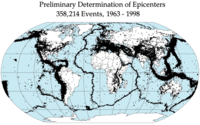
Photo from wikipedia
The seismic capacity of the main Uto City Hall building, which was severely damaged by the 2016 Kumamoto Earthquake, was evaluated by the proposed pushover-based procedure. In this procedure, the… Click to show full abstract
The seismic capacity of the main Uto City Hall building, which was severely damaged by the 2016 Kumamoto Earthquake, was evaluated by the proposed pushover-based procedure. In this procedure, the seismic capacity index of the building is defined as the maximum scaling factor of the seismic input, for which the local responses do not exceed their limit values. From the pushover analysis result, the displacement limit of the equivalent single-degree-of-freedom model was determined. Then, the seismic capacity index was evaluated using an equivalent linearization technique. The evaluated index was re-evaluated by considering the bidirectional excitation. The pushover analysis result revealed that the torsional response is significant in the nonlinear behavior of this building. The evaluated seismic capacity implied that some structural damages, including the yielding of the beam-column joint, may have occurred during the first earthquake on 14 April 2016.
Journal Title: Buildings
Year Published: 2019
Link to full text (if available)
Share on Social Media: Sign Up to like & get
recommendations!